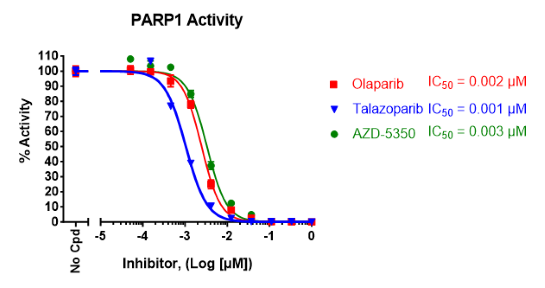PARP1 Homogenous Assay Kit
The PARP1 Homogeneous Assay Kit is designed to measure PARP1 (poly-(ADP-ribose) polymerase 1) activity for screening and profiling applications. The PARP1 Homogeneous Assay Kit comes in a convenient 384-well AlphaLISA® format, with enough purified recombinant PARP1, biotinylated histone substrate, ADP-Ribose Binding Reagent 1 and assay buffer for 400 enzyme reactions.

Figure 1: PARP1 Homogenous Assay Kit schematic.
A sample containing PARP1 is incubated with a biotinylated histone substrate and NAD+ for one hour. This is followed by the addition of acceptor beads and ADP-ribose binding agent, and finally donor beads. Alpha-counts are then measured. Alpha-counts are directly proportional to PARP1 activity.
Need us to run inhibitor screens or profile your compounds against PARP1? Check out our PARP/PARPTrap™ Screening Services or DNA Replication and Repair Screening Services.
- AlphaLISA® Anti-Rabbit IgG Acceptor Beads (Perkin Elmer #AL104C)
- AlphaScreen® Streptavidin-Conjugated Donor Beads (Perkin Elmer #6760002S)
- Optiplate - 384 (Perkin Elmer #6007290)
- AlphaScreen microplate reader
| Catalog # | Name | Amount | Storage |
| 80501 | PARP1, GST-Tag* | 0.4 µg | -80°C |
| 5X PP-01 Assay Buffer | 2 x 1 ml | -80°C | |
| Biotinylated Histone Substrate | 500 reactions | -80°C | |
| 78311 | ADP-Ribose Binding Reagent 1 | 10 µl | -80°C |
| 750 µM NAD+ | 400 µl | -80°C | |
| 0.5 mM DTT | 200 µl | -20°C | |
| 4X Detection Buffer 1NP | 2 ml | -20°C |
*The initial concentration of enzyme is lot-specific and will be indicated on the tube containing the protein.
PARP1, also known as poly-(ADP-ribose) polymerase 1 or NAD+ ADP-ribosyltransferase 1, is part of the PARP family, and it is the most abundant member. ADP ribosylation, which is the addition of an ADP-ribose to a protein, is a reversible post-translational modification of proteins mostly involved in the DNA Damage Response (DDR) pathway. Poly-ADP-ribosylation (termed PARylation) is the addition of linear or branched chains of ADP-ribose. PARP1 participates in DNA repair by non-homologous end joining (NHEJ), homologous recombination (HR), microhomology-mediated end-joining (MMEJ) and nucleotide excision repair. Dysfunction of DDR pathways can lead to oncogenesis. Overexpression of PARP1 has been found in breast and colon cancer, neuroblastoma, and others. This overexpression can lead to increasing MMEJ, an error-prone DNA repair mechanism, and genome instability leading to cancer. In addition to being involved in DDR, PARP1 is also linked to inflammation and type I diabetes. PARP1 inhibitors have been used in cancer treatment with success. In addition to reducing MMEJ, the use of PARP1 inhibitors can lead to synthetic lethality when homologous recombination repair (HRR) mechanisms are already defective, as in the case of BRCA1 (breast cancer susceptibility protein type 1) and BRCA2 deficient cells. Further understanding of the molecular pathways involving PARP1, and this contribution to disease, will continue to pave the way for new therapies for PARP1-linked diseases.
Marques M., et al., 2019 Oncogene 38 (12): 2177-2191.


